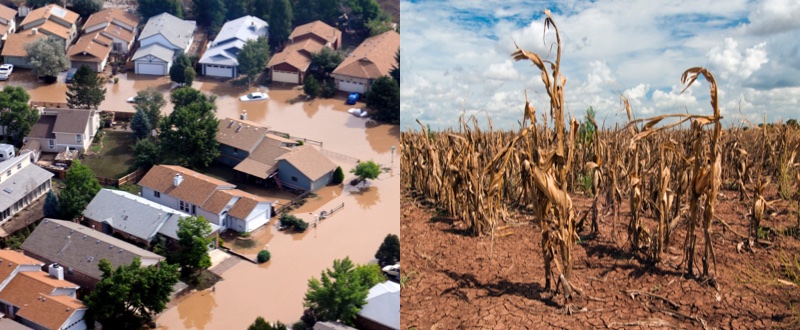Drier and wetter: The future of precipitation variability
New study finds an increase in variability across most of the world
Jan 16, 2018 - by Laura Snider
Jan 16, 2018 - by Laura Snider
Precipitation variability — the swing from dry to wet and back again — will continue to increase across the majority of the world's land area as the climate warms, according to a new study led by scientists at the National Center for Atmospheric Research.
The researchers expect precipitation variability to become greater from day to day, year to year, and even decade to decade. The new research, published in the Nature journal Scientific Reports, provides results from sophisticated computer simulations that predict that there will be both more droughts and more floods within the same areas as the climate warms. The findings are relevant for water managers who need to make long-range plans.
"When it's dry, it will be drier. When it's wet, it will be wetter — in the same place," said NCAR scientist Angeline Pendergrass, lead author of the study. "There will be a broader range of conditions that will become 'normal.'"
The research was funded by the National Science Foundation, which is NCAR's sponsor, and by the U.S. Department of Energy.

Historically, changes in precipitation variability have been difficult to pin down because the amount of rain or snow a particular region gets can vary a great deal naturally.
But in recent years, the availability of large ensembles of climate model runs has allowed scientists to begin separating some of the more subtle impacts of climate change from the natural chaos in the climate system. These ensembles may include 30 or 40 runs of a single climate model over the same time period with slightly different, but equally plausible, initial conditions.
Pendergrass and her colleagues, NCAR scientists Flavio Lehner, Clara Deser, and Benjamin Sanderson, along with ETH-Zürich professor Reto Knutti, took a closer look at precipitation variability using large ensembles of runs from the NCAR-based Community Earth System Model (CESM) and from the Geophysical Fluid Dynamics Laboratory (GFDL) climate model. They also looked at a collection of individual runs taken from many different climate models and known as the Climate Model Intercomparison Project Phase 5, or CMIP5.
The team found that precipitation variability will likely increase substantially over two-thirds of the world's land areas by the end of the century if greenhouse gas emissions continue unabated. They also found that, on average, variability increases 4 to 5 percent over land per degree Celsius of warming and that variability increases across all time scales, from days to decades.
"This increase in variability is arising due to more moisture in the atmosphere and a weakening of global atmospheric circulation," Pendergrass said. "That's important because it means that changes in precipitation variability are not just linked to changes in El Niño and La Niña events, as some previous work implied."
Pendergrass hopes the study's findings will be used by water managers in their future planning. Models used today by water managers often assume that the change in precipitation variability in the future will track with the expected increase in average precipitation.
But the new study finds that the increase in precipitation variability will outstrip the increase in average precipitation, which means that water managers may be miscalculating the magnitude of future swings from wet to dry or vice versa.
"Water managers may be underestimating how much heavy events — floods or droughts — will change," Pendergrass said.
Title: Precipitation variability increases in a warmer climate
Authors: Pendergrass, A. G., R. Knutti, F. Lehner, C. Deser, and B. M. Sanderson
Journal: Scientific Reports, DOI: 10.1038/s41598-017-17966-y